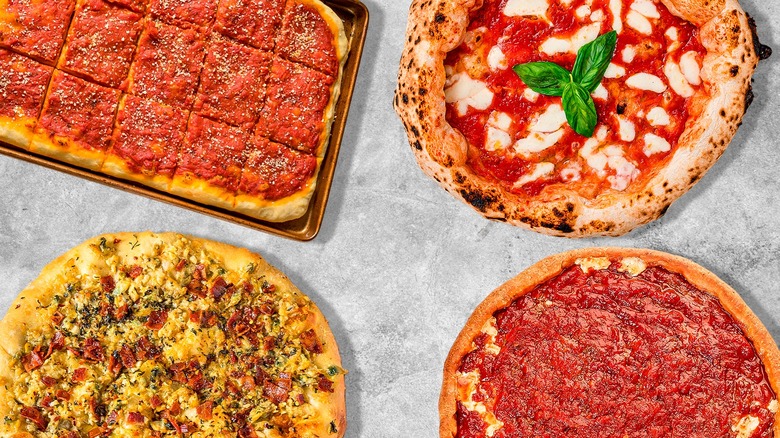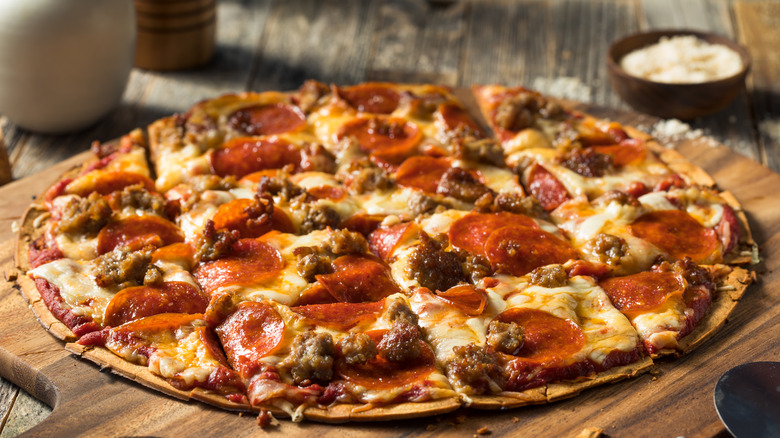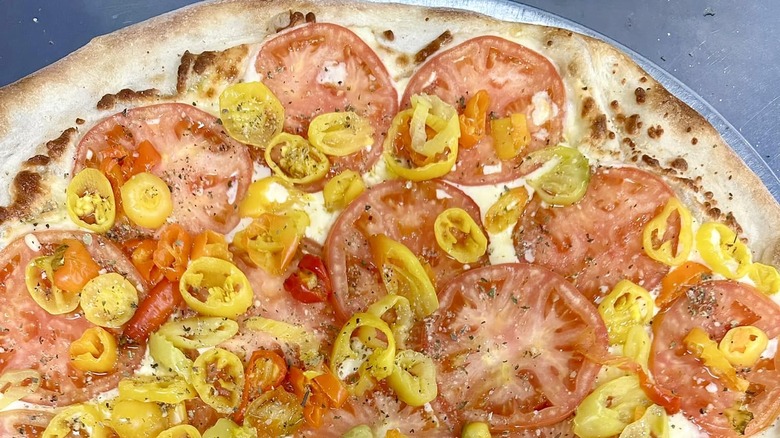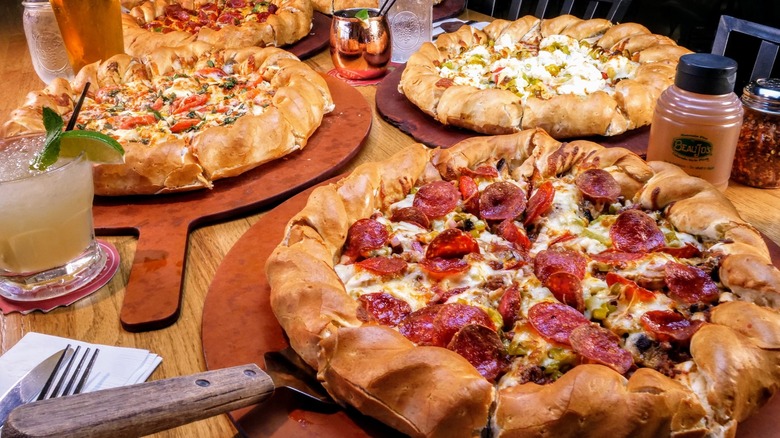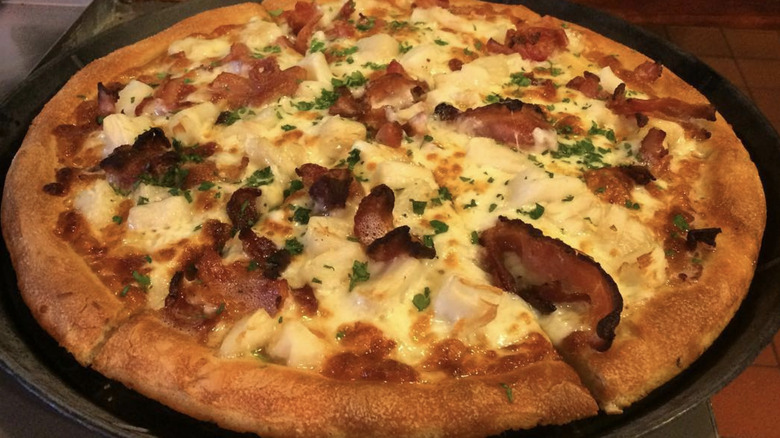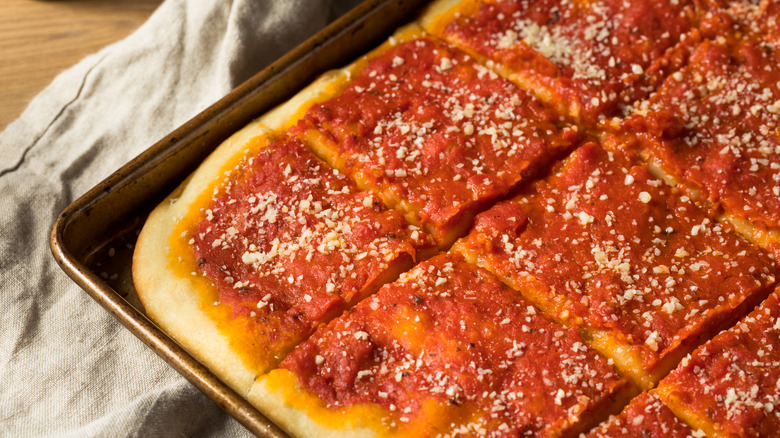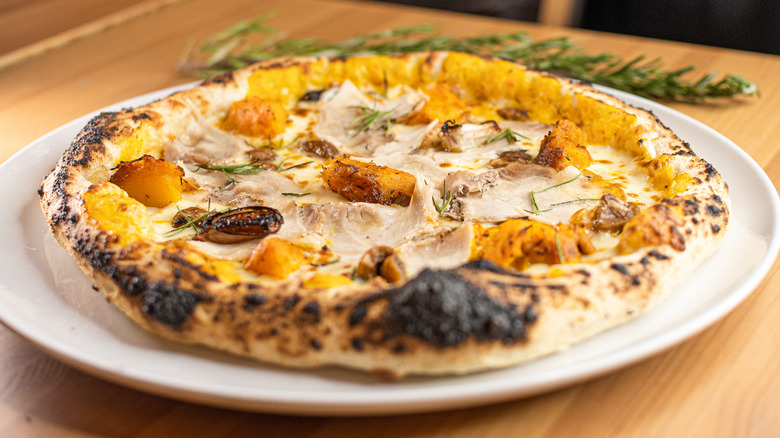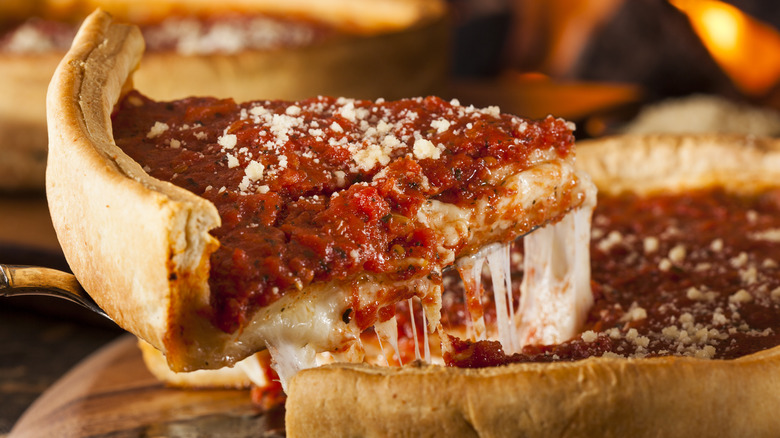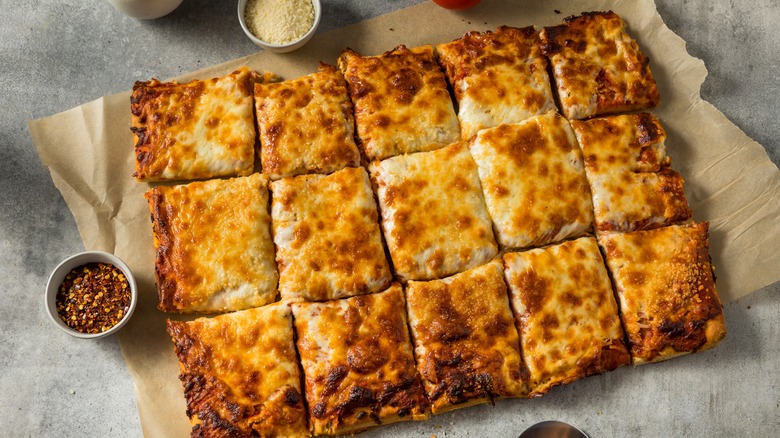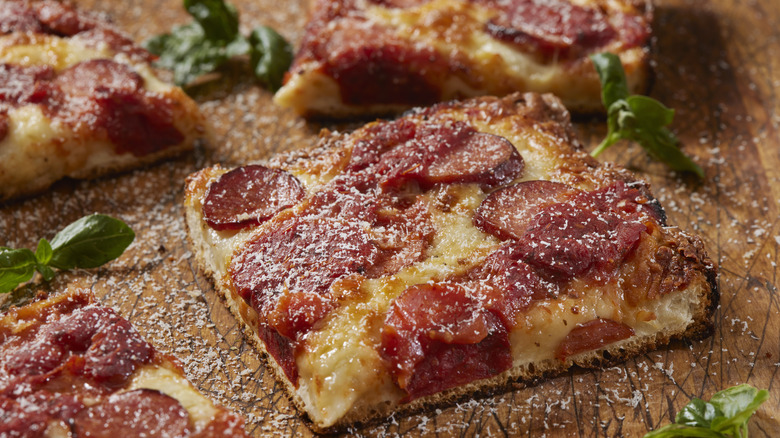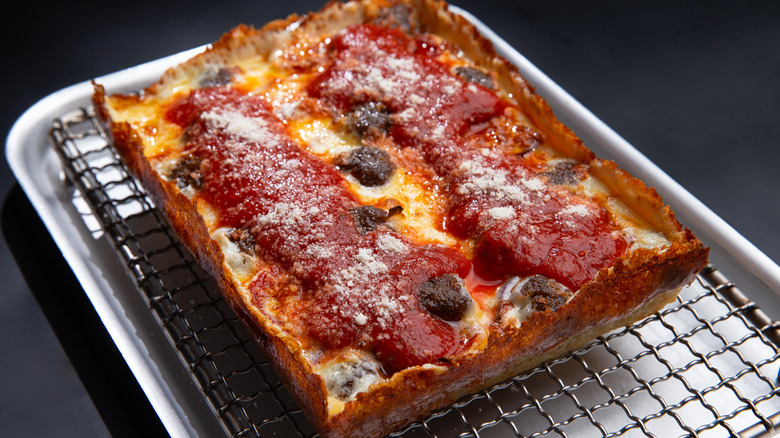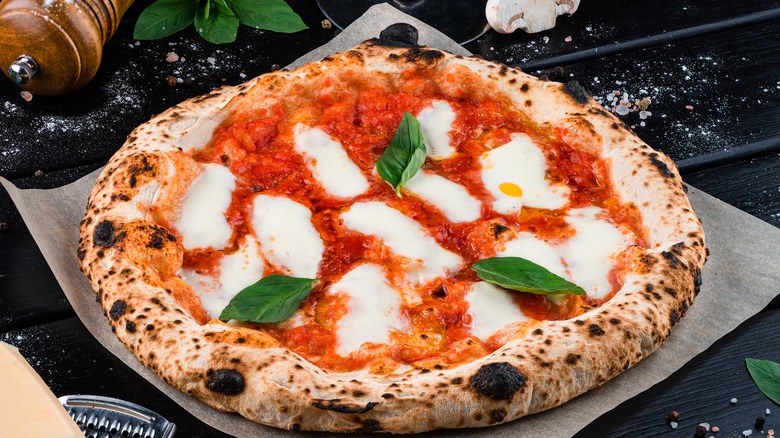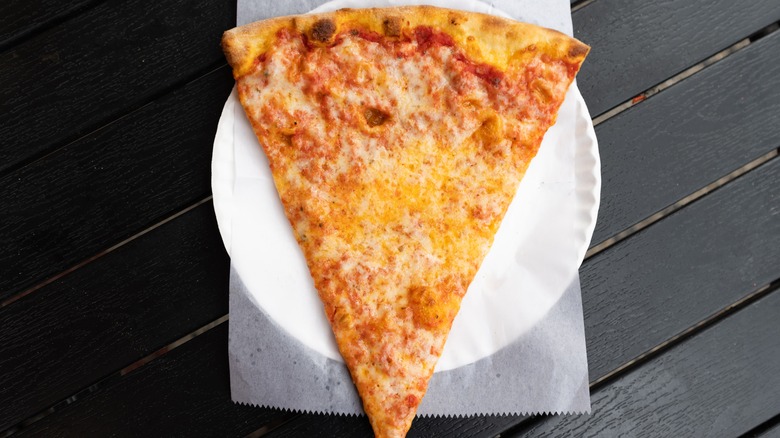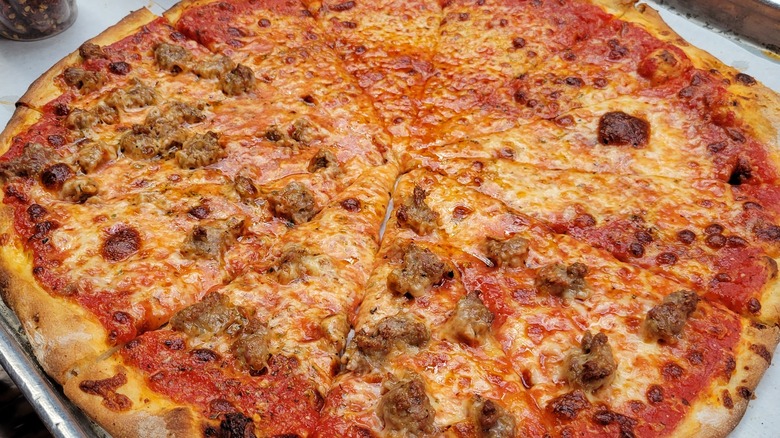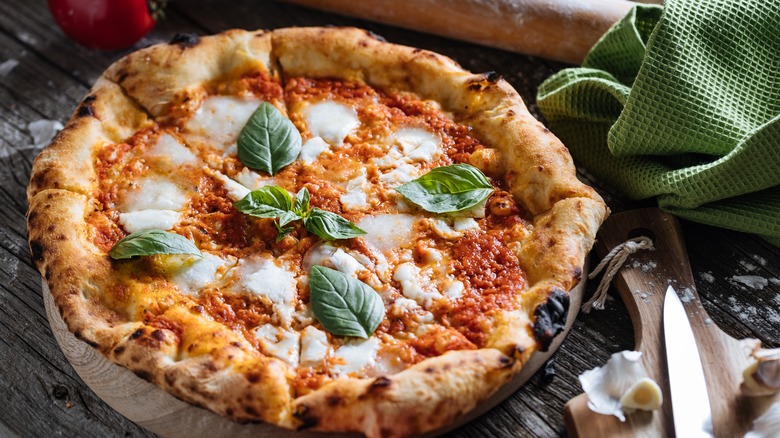14 Pizza Styles, Ranked Worst To Best
I am a pizza snob — and I'm not afraid to admit it. I'd like to think it stems from my roots as a born-and-raised Nutmegger (a person from Connecticut) — which gave me the opportunity to try a melting pot of different pizza styles, from the thin-crust New York slice that's larger than my face to the New England Greek-style pizza that can't decide if it wants to be dressed-up bread or pizza. In fact, I don't even have to travel far out of my hometown to sample a plethora of different regional styles and specialty pies.
I would like to say that I have loved all pizza styles the same, but the fact of the matter is that there are just some slices that will never come close to the others. I ranked some of the most popular pizza styles across the country based on the overall composition of the toppings, the qualities of the crust, and the overall eating experience.
14. Altoona-style pizza
I went to the small town of Altoona, Pennsylvania once. And I can tell you that it wasn't for the pizza. This pizza monstrosity, which you can't really find outside of the region, shares some of the same ingredients as the pizza we know and love. The unique Altoona-style pizza is made by layering a thick, Sicilian-style crust with tomato sauce, salami, green bell peppers, and perhaps the biggest sin of them all: American cheese. Honestly, this pizza lost any ounce of respect from me when someone decided to choose the tar-like, florescent yellow cheese over perfectly good mozzarella. I liken this style more to an open-face grilled cheese that's just "going through a phase."
Besides the horrors beneath its cheese coating, I just can't get over this style's size. It's weighty and massive, and I can't imagine myself scarfing it down to cure a hangover. Luckily for the general population, you will likely not get your hands on a piece unless you travel to Altoona.
13. St. Louis-style pizza
St. Louis-style pizza has all the makings of a good pizza. There's a fair amount of toppings to cover the surface area, while the sauce is often well-balanced and flavorful. But the biggest reason why St. Louis-style pizza will never climb up the rankings is because of its sorry excuse for a crust.
The cracker (sorry... crust) of this pizza is wicked thin. And with a crust this thin, you're bound to have structural issues unless you cook it to the absolute driest it can be without making it inedible. The other issue I have with this pizza is the regionally specific blend of cheeses it's baked with. Provel cheese is a staple for St. Louis-style pizza — and like the lowest-ranking pizza style, there's not an ounce of mozzarella in sight. Instead, eaters of this pizza win the grand prize of eating a confused, melted cheese cracker topped with Swiss, provolone, and cheddar. My biggest respect, though, for St. Louis-style pizza is that it's sauced to the edge, so you get a little bit of sauce, cheese, and toppings in every bite.
12. Pizzaz
The City of Brotherly Love has something special going on with its pizza scene. But its pizzaz isn't as special and delicious as its name suggests, at least compared to some of my higher-ranked options. Philadelphia's pizzaz pizza is a South Philly staple made with the basics: onion and tomatoes for toppings, a solid crust, and American cheese. But the cheese isn't the biggest complaint I have with it. Rather, this style of pizza is missing a sauce, which makes me question why anyone would still feel confident calling it a pizza.
I could see how adding a sauce could be complicated — especially if you're working with particularly wet toppings like tomato. But, the sauce is one of the three things in the holy trinity of pizza making that makes a pie come together. There's salt, umami, and a protective coating to prevent the crust from drying out. Otherwise, it's just a large, fancy cracker. I give it points for being creative, but I draw the line at dropping the sauce.
11. Colorado-style pizza
Colorado-style pizza is a great option if you like eating a pie that's more bread than it is toppings (although it does go hard on the toppings front, too). This pizza, otherwise known as the Colorado Mountain Pie, is traditionally made with a honey-infused crust that imbues it with a brown color and subtly sweet flavor. The crust is also rolled to develop a clearly distinguished edge and crunchy, unique texture. At Beau Jo's in Idaho Springs, where the pizza is quite popular, you'll find pies served with the usual table accompaniments — Parmesan and red pepper flakes — along with a side of honey for dipping and drizzling.
This style of pizza essentially takes the New England Greek pie to a new level. The crust is overwhelming and throws the entire pizza out of balance. And while I like the idea of drizzling honey on my pie as a thoughtful touch, the pies at Beau Jo's are nothing short of excessive. This isn't a slice I could enjoy without needing to have a nap on the couch after.
10. New England-style Greek pizza
New England has a lot of great pizza. It's the home both to the New Haven apizza and the insult to pizza that is the New England-style Greek pizza. Instead of being on the floor of the oven, this pizza is cooked in a circular dish, which gives it a very doughy, bread-like crust. And don't fret, this pie actually has mozzarella on it — just in addition to provolone and cheddar. There is also often a fair amount of cheese on every pie, which makes it very weighty and overwhelming to eat.
The crust isn't as fluffy as the Colorado-style pie, which makes it more reasonable to eat. It's also extra crispy, thanks to an extra coating of olive oil on every surface. But the worst thing about Greek pizza is that the crust is often bent upwards to create a little dish, which really makes for a bready bite that, besides being crisp, lacks flavor.
9. Philadelphia tomato pie
When I see a Philadelphia tomato pie, one word comes to mind: soggy. This pizza (if you can even call it that) was the product of Italian immigrants who flocked to the region in the 19th and 20th centuries. It was made to feed hungry bellies without costing too much, which is why it resembles a focaccia topped with tomato paste rather than an actual pizza. The Philly tomato pie has remained relatively unchanged from generations past, but you may find more toppings like umami-rich anchovies and fragrant herbs. The best part about this pie is how the tomato caramelizes under the heat of the oven, which makes for a deliciously sweet bite.
The Philly tomato pie scored in the middle of the ranking because it is available outside of Philly. Rhode Island-style pizza is very similar and features the same square, fluffy base with tomato topping. Though, while I can appreciate a good tomato pie from time to time, the issue here is that the density of the crust causes this pie to get so wet under the weight of the sauce. You wouldn't have the same problem if you were working with a thin-crust, apizza-style tomato pie.
8. California-style pizza
California-style pizza embodies the California casual aesthetic — just on a yeast-leavened crust. There's an emphasis on locally sourced ingredients, fresh flavors, and toppings that stray away from the idea that pizza has to "just" be mozzarella, pepperoni, and sausage. In technical terms, I would argue that this pizza is more of an approach than a style.
The crust on a California pizza is kept exclusively thin to allow the flavorful toppings to take center stage. It's an especially great pie if you can get a characteristic blister on the crust since it will ground the floral and explosive flavors of the topping with something more sooty. But it's a little too fresh for what I think of when I think of the word "pizza." It won't satisfy the late-night craving for a greasy cheese slice like my top pizza styles, but it will fit the bill if I'm looking for a light, avant-garde version of an Italian classic.
7. Chicago-style deep-dish pizza
Chicago has a lot of great food, from hot dogs to beef sandwiches. But the pizza is not on the list of the city's greatest culinary attractions — at least in my eyes.
Chicago-style deep-dish pizza screams savory pie — not pizza. It's baked in a round tin, and the crust is pressed against the edges, which gives it a pie-like appearance and consistency. Then, it's layered with an array of toppings, cheese, and then a copious amount of sauce before being baked in an oven. As you can probably already guess, this pie is far from finger food. Rather, you have to eat it with a knife and fork — which just seems plain wrong.
The ratio of toppings to crust in a deep-dish pizza is better than that in a Philly tomato pie, which earns it a middle spot in the ranking. Plus, the pie uses the "right" kind of cheese (mozzarella) rather than trying to throw whatever cheese is hanging around in the back of the walk-in refrigerator into it. Its biggest drawback is its abstractness; it's not the greasy pie I want to indulge in because it really doesn't have the true qualities of a pizza.
6. Grandma pie
The grandma pie is a Long Island specialty. It essentially takes Sicilian-style pizza and turns it on its head. Although the shape of the grandma pie is the same as the former, it isn't allowed to rise like a normal, fluffy Sicilian. The pie is also baked on a thin cookie sheet, so it doesn't have nearly the same thickness as other square pies included in this roundup.
This pizza's comparatively thinner crust and unique shape make it easy to replicate in a home kitchen. Plus, the crust is super satisfying because it's coated in copious amounts of olive oil to give it a distinct crunch — no soggy pies here. I also give this pie props for its inclusion of traditional pizza ingredients and the fact that it's relatively easy to eat out of hand. But, the major thing that sets the grandma pie back from my top-ranked brands is that it has a bit too much bready crust for the toppings. It reminds me more of a pizza I would get from a school cafeteria rather than a good local pizza joint.
5. Buffalo-style pizza
While New York City may be considered the best pizza city (both in the state and across the country), pizza can also be found northwest of the five boroughs in Buffalo. Buffalo-style pizza shares qualities of both Detroit-style and New York-style pizza — which makes sense, considering the city's geographic proximity to the two pizza capitals. The crust on a proper slice of Buffalo pizza is thick and weighty, but it is relatively light compared to the toppings. This pie takes cheese to a new level; it can use upwards of three times as much cheese as a standard NYC slice. There's also much more sauce than a conventional city slice, which makes for a heavy pizza that cheese lovers adore.
I appreciate cheese, but in moderation — especially when it comes to pizza. The best part about Buffalo-style pie, though, is that the pepperoni is cupped, so they get a little bit of char on the edges and hold the oil like little teacups. This pie isn't soggy like some of its lower-ranking competitors, but the sheer volume of cheese on top of the pie makes it glorified cheesy bread.
4. Detroit-style pizza
Detroit-style pizza is the one thick-crust style that I will go out of my way to eat. A proper Detroit-style pizza is baked in a square steel pan — which was a historical byproduct of Detroit's once-burgeoning auto industry — until it has a crispy, crackled shell on the edges. The crackle is exciting because it amplifies the sensual experience of eating a slice — and immediately makes you want to go in for another one. Another key feature that sets this pie apart is that the sauce is added on top after the pie is baked, rather than being baked with the cheese and crust. As a result, you get a more pronounced acidic pop from the tomatoes instead of the caramelized effect of a cooked sauce. The balance of flavors and texture with a Detroit-style pizza is sublime– even if each bite is more crust than toppings.
Detroit pizza is undoubtedly messy, and you're bound to walk away with oil on your fingers and sauce on your clothes. And because of the pan shape, it's hard to replicate a Detroit pizza at home. But if you get to try a slice of this perfectly crackly and airy pizza at one of the many pizzerias (even outside of the Motor City), I'm sure you can see why it placed so high on this list.
3. Neapolitan pizza
Neapolitan pizza is rooted in the Naples pizza tradition. The dough is baked in a wood-fired oven, which gives it some characteristic blistering on the crust while keeping the inside plush and soft. This pie is considered to be a thin-crust variety, which is important because it allows the rather simple toppings to take center stage — as they should.
True Neapolitan pizza, although many pizzerias have gravitated away from this pie, really only comes in two styles: Margherita (cheese, tomato sauce, basil, and oil) and marinara (just tomato sauce and herbs). So, there are limited options for what you can do with this pizza as far as toppings. And it's much easier to see the mistakes on a true Neapolitan pizza because you can't hide anything with the toppings. So, I feel that the standard of excellent for a Neapolitan-style pizza is much higher than other varieties I ranked — which is a blessing and a curse. Moreover, while there is beauty in the simplicity and the craftsmanship of this type of pizza, there comes a point where there needs to be a bit more going on.
2. New York-style pizza
A New York-style pizza slice is one of those things that's just so perfect that you would be a fool to mess with it. The key aspect separating this type of pizza from the wood-fired Neapolitan-style pizza is that it's historically made in either coal or a gas-powered oven. The expansion of gas-cooking technologies, following the gradual phasing out of coal, led to slices that could be cooked quicker and cheaper and didn't require the same grunt work of hauling and firing the coal. This pizza style met the growing niche of hungry New Yorkers, and the two quickly became the perfect match.
I love a greasy slice of New York pizza and would argue that it's best eaten cold from the fridge on day two. There is a fantastic balance of crust to cheese, and there are endless toppings that you can adorn your slice with without straying too far from the quintessential New York slice. But my only issue with this pizza is that it's rarely crispy on the bottom, so each slice has to be held and enjoyed with two hands. Luckily, my top pick solves that problem.
1. New Haven apizza
Would you be surprised that a native Nutmegger like myself would pin New Haven apizzas their top pick? Probably not. But there's not much that I can fault this distinct style of pizza for. It has a perfectly crispy crust, a generous amount of cheese, and a subtly tart sauce that ties the entire pie together with a neat little bow on top. You can even venture from the traditional "mootz" topping and go with a classic clam pie with olive oil, garlic, and chopped clams or a tomato pie that swaps the mozzarella with Pecorino Romano.
Naysayers will surely chime in with, "But it's burnt!" And first of all, it's charred crust — not burnt. If you're going to be accusatory, at least get your facts straight. This crispy hot-spot effect just adds to the overall experience of eating a New Haven-style pie. You get the sooty flavor on the tip of your tongue, along with the sloshing oil that sits atop a perfectly baked pie. Unlike the lower-ranked pies, you won't have to worry about an apizza (at least, a properly baked one) coming out soggy, and the toppings are always spread out to the edge of the pie. It can't get much better than that.
Methodology
I love all things about pizza, but not exactly every style. In my albeit short life, I have met pizzas that I have loved and those that I have vowed never to eat again. This list chronicles these styles, which are found in various regions across the United States.
There are many things I look for in a "good" pizza style. Above all, I look for balance. This extends to the ratio of crust to toppings, as well as how well the pizza comes together as a whole — rather than just a smattering of ingredients someone pulled out of the back of their fridge. The perfect pizza is crisp, not soggy, and can be eaten in a variety of settings. Above all, I want a pizza that will taste the same whether I grab it as a late-night snack on the way home from the bar or indulge in it as the centerpiece of a family dinner.
